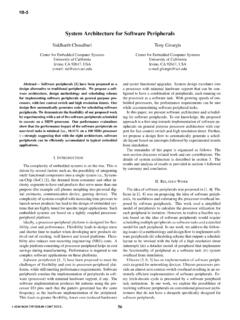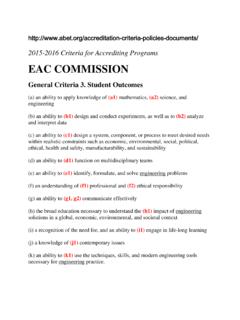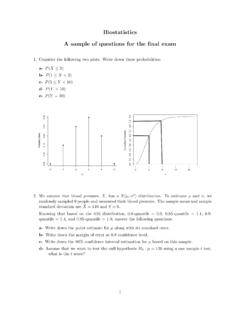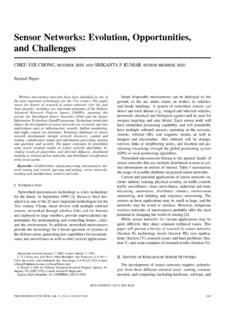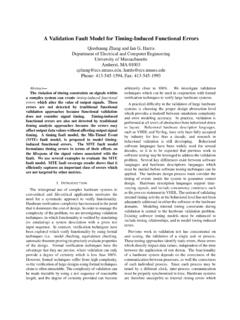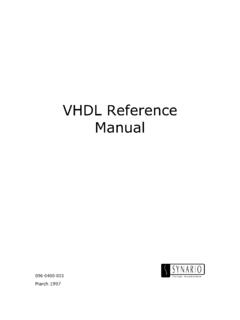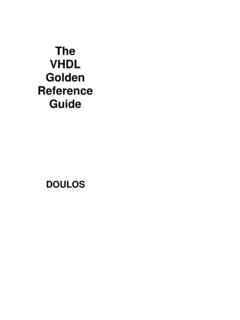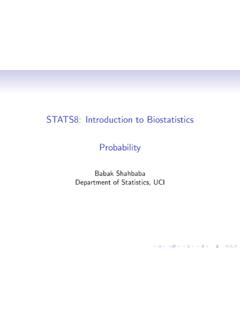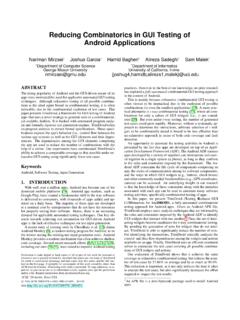Transcription of Learning Materials for Introductory Embedded Systems ...
1 Paper ID #15723 Learning Materials for Introductory Embedded Systems programming Us-ing a Model-Based DisciplineProf. Frank Vahid, University of California - RiversideFrank Vahid is a Professor of Computer Science and Engineering at the Univ. of California, research interests include Embedded Systems design, and engineering education. He is a co-founderof Alex Daniel Edgcomb, ZybooksAlex Edgcomb finished his PhD in computer science at UC Riverside in 2014. Alex has continued work-ing as a research specialist at UC Riverside with his PhD advisor, studying the efficacy of web-nativecontent for STEM education.
2 Alex also works with Zyante, a startup that develops interactive, web-nativetextbooks in Bailey Alan Miller, Zyante Miller is a software engineer at Zyante Inc., and formerly worked as a software engineer at SpaceExploration Technologies Corporation (SpaceX). He received his in Computer Engineering, and and in Computer Science, from the University of California, Riverside in 2009, 2011, and2014, respectively. His dissertation research focused on Embedded Systems design and novel highly-parallel many-core computer architectures.
3 He has published more than 10 research papers, and served asa university lecturer in computer Tony Givargis, University of California - IrvineTony Givargis is a Professor of Computer Science and Associate Dean in the School of Information andComputer Sciences at the University of California, Irvine. He received his and in ComputerScience from the University of California, Riverside in 1997 and 2001, respectively. He conducts re-search in the area of Embedded Systems with an emphasis on Embedded Systems and software and hasauthored over 90 peer reviewed papers.
4 He is a named inventor on 11 patents and has co-authoredtwo popular textbooks on Embedded system design. Professor Givargis has received numerous teaching,service, and research awards, including the Frederick Emmons Terman Award, presented annually to anoutstanding young electrical engineering educator by the Electrical and Computer Engineering Divisionof the American Society for Engineering American Society for Engineering Education, 2016 Learning Materials for Introductory Embedded Systems programming using a Model Based Discipline Frank Vahid, Computer Science & Engin.
5 , Univ. of California, Riverside (also with zyBooks) Alex Edgcomb, zyBooks, Los Gatos, California (also with UC Riverside) Bailey Miller, zyBooks, Los Gatos, California Tony Givargis, Department of Computer Science, University of California, Irvine Abstract 'sand growthinthe1980's,embeddedsystemsconsist edofrelativelysimplemicrocontrollerhardw are, oftenprogrammedinlow levelassemblylanguage,toconfigureafewper ipheralsandinteract ,improvementsinspeed,memorysize,andpower have changedtheemphasisfromhardwaretosoftware ,withmicrocontrollerssupportingtensof thousandsoflinesofcode,perhapsprogrammed inC.
6 Oftenwithconcurrenttasks,interacting withdozensofperipheralsandpotentiallyhun dredsofinput/outputpinsintime multiplexed manner, ,manyuniversity embeddedsystemscoursesandtextbooksstilll ooksimilartothoseinthe1980's,emphasizing low coursehowtoprogramusinghigher foundationandperspective,leadingtoadhocu nstructuredcode,orover relianceandinefficient useofreal ,wedescribeamodel based disciplineforintroductoryembeddedsystems courses,developedoverthepastdecadeatthe UniversityofCalifornia,RiversideandUnive rsityofCalifornia, studentsdescribingdesiredbehaviorusingsy nchronousstatemachines,andcapturingthose state ,studentsdevelopsoftwarepayingstrictatte ntion totimingissues,andcreatetheirownC basedtaskscheduler,leadingtoasolidunders tandingof concurrencyandreal , anddescribesnewweb basedinteractivelearningmaterialemphasiz ingthediscipline.
7 Whichis paper also introduces web based tools that support the discipline. Introduction the1980s,mostembeddedsystemswereprimaril ylow complexitydevicesliketelephone textbooksbegantoappearinuniversities,ori ginallyusingnameslikemicroprocessor based serialcommunicationhardware,pulsewidthmo dulators,keypads, originallyfocusedontheassemblylanguageof aparticularmicroprocessorormicrocontroll er, evolving to C or other high level languages in the 1990's/2000's.
8 Today,evenrelatively simpleembeddedsystemsinpracticemayconsis toftensofthousandsof ,introductorycoursesandtextbooksmainlyst illfocusonconfiguringand interfacingwithperipherals,withlittlegui danceprovidedtostudentsonhowtowriteprogr ams thatareelegant,robust, ,including muchcommercialcode,followsnoparticularpr ogrammingdiscipline,ispronetobugs,andis ,or experiencefailuresinthefield,asaresult 1 .Someuniversitieshaveintermediateoradvan ced coursesthatintroducereal timesystemsprogrammingincludingmulti taskprogramming,but manyembeddedsystemsstudentsdonothaveacce sstosuchcourses,orhavealreadydeveloped ,suchcoursesstillmaynotteachadisciplinef orhowto program each task.
9 Beginningabout10yearsago,researchersatth eUniversityofCalifornia,atRiversideandat Irvine,withsupportbytheNationalScienceFo undation,begandevelopingnewmaterialsand accompanyingsimulatorsintendedtobringmod el baseddiscipline(wellknownbytheresearch community)intofirstcoursesonembeddedsyst ems 4,6 .Thematerialsintroducemodel based designjustweeksintoasemesterofafirstembe ddedsystemscourse, researchersdevelopedaspecialformofstatem achinesintendedtobeeasytounderstandby beginnersyetsufficientlypowerfulforcomme rcialuse,utilizingC thinkintermsofstatemachines, oncapturingdesiredbehaviorcorrectly,then choosingperiodstosampleinputsandgenerate ,studentslearntousemultiple concurrentstatemachines(tasks)
10 Tokeepdistinctbehaviorsdistinct,andtocom municateand ,andto writeasimpletaskschedulerinCaswell,servi ngwellformanycommercialsystems,aswellas providinganexcellentfoundationforsubsequ entintroductiontoreal timeoperatingsystems (providingasolidunderstandingofwhatis"un derthehood").Thematerialaimstohelpmake introductoryembeddedsystemsaseriousengin eeringdiscipline,withlecturematerialcove ring the"theory"ofmodel basedprogramming(makinguseofthenewmateri alandsimulator),and labscoveringthe"practice"ofconfiguring,i nterfacing,andprogramminganactual microcontroller on a breadboard.
